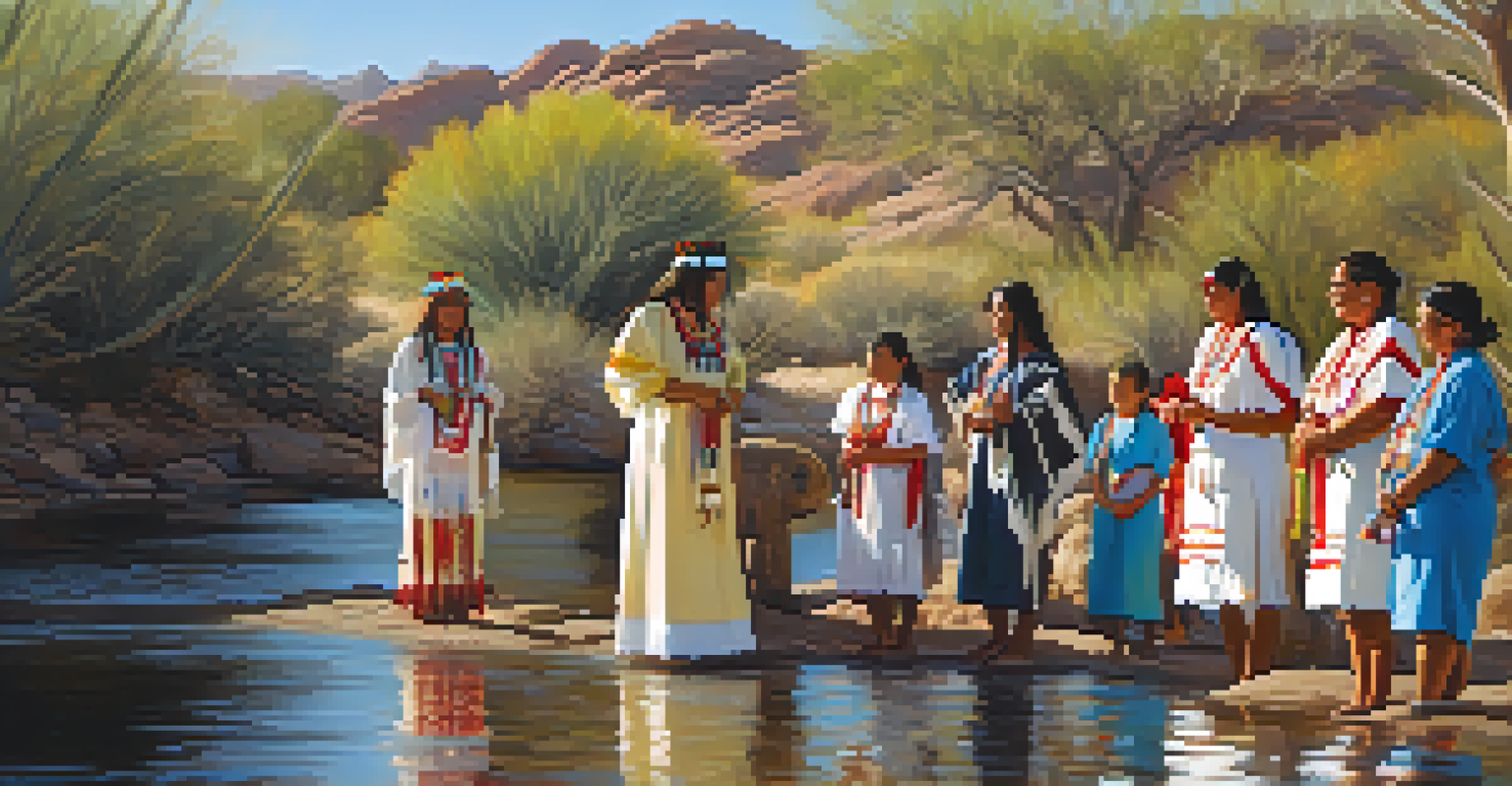Cultural Significance of Water in Tucson's History

The Lifeblood of Tucson: Water's Role in Survival
Water has been essential for survival in Tucson, a desert city where rain is scarce. Indigenous peoples, such as the Tohono O'odham, adapted their lifestyles around the availability of water, creating sophisticated irrigation systems to cultivate crops in arid conditions. These early innovations laid the groundwork for future agricultural practices in the region.
Water is the driving force of all nature.
As Tucson grew, the need for reliable water sources became even more critical. Settlers implemented advanced techniques for capturing rainwater and developing wells, which were vital for sustaining both the population and the burgeoning economy. This ingenuity highlights how water shaped the very foundations of Tucson's community.
Understanding Tucson's history without acknowledging the significance of water is nearly impossible. It has not only supported physical sustenance but also fostered cultural connections among the diverse groups that have inhabited the area over centuries.
Water: A Symbol of Life and Community
In Tucson, water transcends its practical uses, evolving into a symbol of life and community cohesion. Festivals celebrating seasonal rains or agricultural abundance illustrate how water is woven into the social fabric of the region. These events foster a sense of belonging and shared identity among residents.

The importance of water is also reflected in local traditions and rituals. Many Native American tribes hold sacred water ceremonies, recognizing its spiritual significance as a source of life and purification. These practices have been passed down through generations, emphasizing the deep-rooted reverence for water in Tucson's culture.
Water's Historical Significance
Tucson's growth and cultural identity have been profoundly shaped by innovative water management practices and historical reverence for this vital resource.
In contemporary times, Tucson continues to celebrate water through art, literature, and community initiatives. This ongoing relationship underscores the city's commitment to preserving its water resources and honoring its historical significance.
Historical Innovations: Water Management in Tucson
Tucson's history is marked by innovative water management techniques that have enabled its growth. From the early Hohokam civilization, who constructed extensive canal systems, to modern conservation efforts, the community has continuously adapted to the challenges posed by its environment. These historical innovations reflect a profound understanding of water's importance.
Thousands have lived without love, not one without water.
In the 19th century, the arrival of settlers brought new technologies that transformed water access. The establishment of aqueducts and reservoirs helped facilitate Tucson's expansion, leading to a flourishing agricultural economy. This shift not only supported population growth but also attracted new residents eager to partake in the opportunities afforded by the abundant resources.
Today, Tucson's approach to water management includes sustainable practices aimed at preserving its precious resources. From rainwater harvesting to wastewater recycling, the city is setting an example for how to balance growth and environmental stewardship.
Water and the Environment: A Delicate Balance
In Tucson, water is not just a resource; it's a crucial component of the environment. The region's unique ecosystem, which includes diverse flora and fauna, relies heavily on the availability of water. Understanding this delicate balance is essential for maintaining both the natural landscape and the community's needs.
Over the years, urban development has put pressure on local water sources, raising concerns about sustainability. Efforts to restore riparian habitats and protect groundwater are vital to ensuring that both people and wildlife can thrive in this desert ecosystem. Education and community involvement play significant roles in these initiatives.
Cultural Ties to Water
Water serves as a symbol of life and community in Tucson, reflected in local traditions, art, and literature that celebrate its importance.
The relationship between Tucson's residents and their environment exemplifies the ongoing challenge of managing water resources responsibly. As climate change continues to impact rainfall patterns, fostering a culture of conservation will become increasingly important for preserving the region's ecological integrity.
Cultural Expressions: Water in Art and Literature
Water's significance in Tucson extends to its artistic and literary expressions. Local artists often draw inspiration from the region's rivers and lakes, capturing the beauty and importance of water through various mediums. These artworks serve as a reminder of the essential role water plays in shaping the landscape and the community's identity.
Literary works, too, reflect Tucson's relationship with water. Authors weave narratives that explore themes of survival, resilience, and connection to the natural world. These stories resonate with readers, emphasizing the emotional and cultural ties that bind the community to its water sources.
By celebrating water through art and literature, Tucson fosters a deeper understanding of its cultural significance. These creative expressions encourage dialogue about the importance of preserving water resources for future generations.
Modern Challenges: Water Scarcity and Conservation
As Tucson faces the realities of climate change, water scarcity has emerged as a pressing challenge. The city's rapid growth and increasing demand for water resources have raised concerns about sustainability. Addressing these issues requires innovative solutions and collective action from the community.
Efforts to promote conservation have become essential in ensuring Tucson's water future. Initiatives like xeriscaping and rainwater harvesting encourage residents to adopt sustainable practices that reduce water consumption. By fostering a culture of conservation, the community can safeguard its vital resources.
Challenges of Water Scarcity
As climate change intensifies, Tucson faces significant water scarcity challenges, necessitating community action and sustainable practices to preserve its resources.
Public awareness campaigns and community engagement play crucial roles in tackling water scarcity. By educating residents about the importance of responsible water use, Tucson can create a more sustainable future while honoring its rich cultural heritage.
Looking Ahead: The Future of Water in Tucson
The future of Tucson's water resources hinges on the community's ability to adapt and innovate. As climate patterns shift, proactive measures must be taken to ensure a stable water supply for generations to come. Collaboration among community members, local governments, and environmental organizations will be vital in this effort.
Investments in technology and infrastructure can enhance water management practices, making them more efficient and sustainable. By prioritizing conservation and responsible usage, Tucson can pave the way for a resilient future that honors its cultural roots.

Ultimately, the story of water in Tucson is one of resilience and adaptation. By embracing its historical significance and committing to sustainable practices, the city can continue to thrive as a vibrant community deeply connected to its water resources.